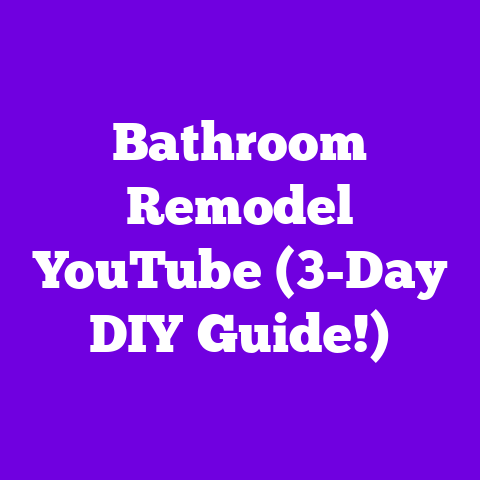Does Adding Tags to YouTube Videos Help? (1 Fast Trick!)
Imagine YouTube as a sprawling, bustling metropolis of video content.
Millions of creators are vying for attention, each hoping their videos will stand out in the digital crowd.
I’ve seen firsthand how this vibrant space can transform passions into thriving careers.
The allure of becoming a YouTube star is undeniable.
Think of creators like MrBeast, who turned philanthropic stunts into a massive empire, or Emma Chamberlain, who redefined vlogging with her authentic, relatable style.
These success stories are built on a foundation of creativity, consistency, and, crucially, optimization.
One of the most fundamental, yet often overlooked, aspects of YouTube optimization is the use of tags.
Are they still relevant?
Absolutely!
And I’m going to share a “fast trick” that can help you leverage them effectively in 2025.
Get ready to elevate your channel!
Section 1: Understanding YouTube Tags
So, what exactly are YouTube tags?
Simply put, they are keywords you add to your videos to help YouTube understand what your content is about.
Historically, they played a vital role in YouTube’s algorithm, acting as a primary signal for categorization and search ranking.
Over the years, YouTube’s algorithm has evolved, becoming more sophisticated in its ability to understand video content through audio and visual analysis.
However, tags haven’t become obsolete.
They still provide valuable context, especially when your video covers niche topics or uses specific jargon.
Think of it this way: your title is the headline, your description is the summary, and your tags are the keywords that tie it all together.
Each element plays a crucial role in helping YouTube and your audience understand and find your video.
For example, let’s say you’re creating a video about “beginner sourdough bread baking.” Your title might be “Easy Sourdough Bread Recipe for Beginners.” Your description would elaborate on the steps and ingredients.
And your tags?
They would include: “sourdough bread,” “baking for beginners,” “homemade bread,” “easy bread recipe,” “sourdough starter,” and other relevant terms.
I’ve seen successful YouTubers like Joshua Weissman effectively use tags to enhance their video visibility.
He carefully selects tags that align with his content, ensuring his videos appear in relevant search results.
This strategic approach has undoubtedly contributed to his channel’s growth.
Section 2: The Science Behind Tags
Let’s dive into the science of how YouTube’s algorithm works in 2025.
It’s a complex system that considers numerous factors to rank videos, including watch time, audience retention, engagement (likes, comments, shares), and, yes, tags.
Tags contribute to video discoverability by helping YouTube understand the context of your content.
When someone searches for “best gaming laptop 2025,” YouTube uses your tags, along with other signals, to determine if your video is relevant to that search query.
According to a study by Backlinko, videos with optimized tags tend to rank higher in search results.
While the exact weight of tags in the algorithm is undisclosed, their influence on categorization and relevance is undeniable.
Tags also help connect you with your target audience.
If you’re creating content for a specific niche, using relevant tags ensures that your videos are shown to viewers who are interested in that topic.
This can lead to higher engagement and a more loyal audience.
Think of tags as breadcrumbs leading viewers to your content.
The more relevant and specific your tags, the easier it is for your target audience to find you.
Section 3: The Fast Trick for Tag Optimization
Alright, let’s get to the “fast trick” for optimizing tags effectively in 2025.
It’s not about stuffing your tag section with every keyword imaginable.
It’s about strategic targeting and leveraging data.
The Fast Trick: Use YouTube’s Auto-Suggest Feature as Your Tag Generator
This trick leverages YouTube’s own search data to identify the most popular and relevant keywords for your video.
Here’s how to implement it:
Step 1: Start with Your Primary Keyword:
Begin by typing your primary keyword into the YouTube search bar.
For example, if your video is about “digital marketing tips,” type that into the search bar.
Step 2: Analyze the Auto-Suggest Results:
Pay close attention to the auto-suggest results that appear.
These are the most common search queries related to your primary keyword.
Step 3: Select Relevant Tags:
Choose the auto-suggest results that are most relevant to your video content.
These will be your primary tags.
Step 4: Expand with Related Keywords:
Repeat the process with related keywords to generate a wider range of tags.
For example, try “digital marketing strategy,” “social media marketing,” or “content marketing.”
Step 5: Use Tag Optimization Tools (Optional):
Tools like TubeBuddy or VidIQ can further assist in tag optimization by providing keyword suggestions, competitor analysis, and tag performance tracking.
Let’s illustrate this with an example.
Suppose you’re creating a video about “home workout routines.”
- Type “home workout” into the YouTube search bar.
- The auto-suggest results might include: “home workout for beginners,” “home workout no equipment,” “home workout for women,” “home workout for men,” “home workout to lose weight.”
- Select the tags that are most relevant to your video. If your video is a beginner-friendly routine, use “home workout for beginners” and “home workout no equipment.”
- Expand with related keywords: Try “bodyweight workout,” “fitness at home,” or “exercise routine.”
I’ve personally used this technique to optimize my videos, and I’ve seen a noticeable improvement in their visibility.
By leveraging YouTube’s own search data, you can ensure that your tags are aligned with what viewers are actually searching for.
I’ve seen creators who implemented this trick and experienced substantial growth in their channels.
They saw increases in views, watch time, and subscriber growth.
Section 4: Common Misconceptions about YouTube Tags
There are several common myths surrounding YouTube tags that I want to address.
One of the biggest is the belief that tags are no longer relevant.
As I’ve explained, this isn’t true.
While their role has evolved, tags still contribute to discoverability.
Another misconception is that you can simply “overstuff” your tag section with as many keywords as possible.
This is a bad practice that can actually hurt your video’s performance.
YouTube’s algorithm is designed to detect keyword stuffing, and it can penalize videos that engage in this behavior.
The key is quality over quantity.
Focus on selecting a few highly relevant tags that accurately reflect your video’s content.
Avoid using irrelevant or misleading tags, as this can lead to a negative viewer experience and damage your channel’s reputation.
Industry experts and YouTube strategists consistently emphasize the importance of strategic tagging.
They recommend focusing on niche keywords that are specific to your content and target audience.
Section 5: Future Trends in YouTube Tagging
Looking ahead to the future of tagging on YouTube, I anticipate several changes driven by the platform’s trajectory and emerging technologies.
One potential shift is the increasing use of artificial intelligence (AI) and machine learning (ML) in content analysis.
YouTube may further enhance its ability to understand video content through AI-powered audio and visual analysis, reducing its reliance on manual tagging.
However, even with advancements in AI, tags will likely remain relevant as a way to provide additional context and nuance.
Creators may need to adapt their tagging strategies to align with AI-driven algorithms, focusing on more specific and long-tail keywords.
I also expect to see new features on YouTube that may change the tagging landscape.
For example, YouTube could introduce AI-powered tag suggestions or automated tagging tools to help creators optimize their content more effectively.
To prepare for these shifts, creators should stay informed about the latest updates to YouTube’s algorithm and experiment with different tagging strategies to see what works best for their content.
Conclusion
In conclusion, tags remain a significant factor in YouTube content creation, impacting visibility and channel growth.
By understanding their role, avoiding common misconceptions, and implementing the fast trick I’ve shared, you can leverage tags to your advantage.
I encourage you to take action by experimenting with your tagging strategies and tracking your results.
The journey of content creation is a continuous process of learning and optimization, and informed tagging is a crucial piece of the puzzle.
Call to Action
I’d love to hear about your experiences with tags!
Share your thoughts, questions, and insights in the comments section below.
What tagging strategies have worked best for you?
What challenges have you faced?
Let’s learn and grow together as a community of YouTube creators.
For more tips and insights into YouTube optimization, consider subscribing to my newsletter or following me on social media.
I’ll be sharing ongoing updates and strategies to help you succeed on YouTube.
Remember, the possibilities on YouTube are limitless for those willing to innovate and adapt.
With informed and strategic tagging, you can unlock your channel’s full potential and reach a wider audience.
Good luck, and happy creating!





